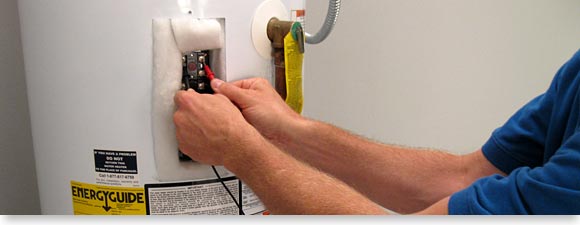Troubleshooting and Repair of a Standard Electric Water
Heater
No Hot Water
"Replacing A Heating Element"
It may take several hours for a newly installed electric water
heater to reach normal operating temperature. If you don't have hot
water after two hours (water not even warm), first check to make
sure the water heater is getting electrical power. Not getting
power is a common reason new water heaters don't work.
Checking for Electrical Power
You can check for power with a simple "circuit tester," but for
a more complete diagnosis of electrical problems, you'll need a
meter that measures voltage.
To check for power, turn the circuit breaker marked "water
heater" off (or remove fuses). Remove the water heater's upper
access panel. Carefully remove the insulation and plastic cover.
Identify the power supply wires. Usually, these connect to the top
two screws of the upper thermostat. Turn the circuit breaker back
on and check for voltage on the top two screws of the upper
thermostat.
The label on the water heater indicates what voltage the water
heater requires. Most residential units are 220/240 volts (but some
are 110/120 volts). Verify your water heater is getting the correct
voltage. If it is not getting the required voltage, there are
probably issues with your home's electrical system. A qualified
electrician may be needed to fix your electrical problem. Turn the
circuit breaker off, replace the plastic cover, insulation and
access panel.

Testing Thermostat for Power with Voltmeter
If the unit is powered with the correct voltage, and still does
not produce any hot water, the upper heating element has probably
burned out. A water heater must be completely full of water before
electric power is applied or the upper heating element will burn
out (this is called Dry Fire). The Installation Instructions
require that a hot water faucet be opened and the hot water allowed
to run full for at least three minutes before turning the power on.
This is to make sure all of the air has been removed from the tank,
and the tank is completely full of water. If the upper element has
burned out, it can be replaced. Replacement heating elements are
inexpensive and widely available. After the heating element has
been replaced, make sure the tank is completely full of water
before turning the power back on.
Some Hot Water, but Not Enough (New Installation)
If a new water heater produces some hot water, but not as much
as you're used to or not as much as you need, the thermostats may
need adjusting. The Installation Manual has temperature adjustment
instructions for your unit as well as important safety information
about scalding. Water heater manufacturers recommend a temperature
setting of no higher than 120ºF. Higher temperatures increase the
risk of scalding injuries. Read and follow the temperature
adjustment instructions and safety notices in the Installation
Manual that came with your new water heater. Remember, higher
temperatures (above 120ºF) can cause serious injuries.
Another possibility is that the water heater is not getting the
correct voltage (see Checking for Electrical Power above).
It is also possible that the water heater is too small or that your
usage has increased.
Water Leaks
With a new water heater, most leaks are caused by leaking
connections at the hot water outlet or cold water inlet.
Occasionally, leaks can be found coming from a fitting (such as
around the Temperature and Pressure Relief Valve) or around one of
the heating elements. Leaking fittings can often be tightened or
repaired. It is extremely rare for a new tank to leak.
"Electric Thermal Expansion Tank"
Water Drips
If drips are noticed coming from the discharge pipe of the
Temperature and Pressure Relief Valve, the home's water pressure
may be too high or a thermal expansion tank may be needed.
Note - If large quantities of hot
water are coming from the discharge pipe, turn electrical power off
and consult a qualified technician. Do not cap or plug the
discharge pipe.
Water Pressure
Check your home's water pressure with a gauge. The recommended
water pressure is 50 to 60 PSIG. If the pressure is higher than
that, install a Pressure Regulating Valve (or adjust your existing
pressure regulating valve if you have one). For water pressure
issues, consult your local water utility or a qualified plumber.
Most plumbing codes require a Pressure Regulating Valve if the
water pressure is above 80 PSIG.
Thermal Expansion Tank
When water is heated, it expands. In older homes, the expanded
water pushed back into the water main. Today, most homes have
backflow prevention valves which stop the water in your home from
reentering the water supply. These valves can be inside water
softeners, pressure regulating valves or the water meter itself.
Backflow prevention valves (also known as "check valves") prevent
the expanded water from reentering the water main. Since the
expanded water now has nowhere to go, the water pressure in the
house's pipes can increase dramatically, often to the point where
the Temperature and Pressure Relief Valve discharge pipe drips. A
thermal expansion tank has an internal air bladder which can absorb
the expanded water, protecting plumbing, appliances and the water
heater. For these reasons, most homes now need a thermal expansion
tank (and a properly adjusted pressure regulating valve). Not
having a thermal expansion tank is the most common reason for a
dripping discharge pipe.
|
WARNING! Do Not Cap or Plug the Temperature and Pressure
Relief Valve Discharge Pipe. Explosion Hazard.
|